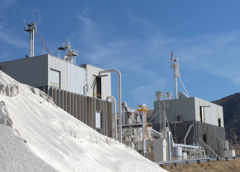A volatile commodities market has impacted mining companies’ profitability and sustainability in recent years, according to “The Connected Mine,” a white paper released by Rockwell Automation.
Whether this situation continues for the foreseeable future or a turnaround is just around the corner remains to be seen, but the fact is it’s having a transformative effect on mining operations and business priorities.
Today, mining companies are focusing their operational investments on areas that can help them maximize yield recoveries and improve operating efficiencies while still meeting regulatory requirements and maintaining safe or “zero harm” working environments. They’re also seeking opportunities to better utilize their shrinking pool of skilled workers, and to gain new flexibility to meet future supply chain demands.
Connected or “smart” operations can help in all of these areas. Greater connectivity and information sharing can help mining companies better understand their operations, improve their performance and reduce safety risks.
The Power of Information
Some of the largest mining companies in the world are already harnessing the power of connected operations to significantly transform their operations.
- They’re using connected devices and smart machines to capture real-time process information and make better business decisions.
- They’re gaining deeper insights into their equipment to improve asset productivity. They’re identifying and reducing variability across their processes.
- They’re using greater connectivity to establish remote-operations centers and support autonomous material transportation.
Beyond these operational benefits, companies are using better connectivity to help better track employees for enhanced safety, improved metal accounting and to achieve significant energy savings.
This is the connected mine. It’s created from the convergence of traditionally separate information technology (IT) and operations technology (OT) systems into a single, unified network infrastructure that allows for seamless connectivity and information sharing across the mining enterprise. It’s enabled by emerging technologies for the mining sector, such as advanced diagnostics, cloud computing and remote access.
Cloud solutions, for example, can be used for important safety and security communications such as underground ventilation information to keep workers appraised of environmental conditions. Companies can harness the power of a connected mine to capture greater value from their operations in three key ways:
- Operational intelligence.
- Reduced safety risks.
- Remote and autonomous operations support.
Four Tips for Creating a Connected Mine
1. Modernize and standardize control equipment and software for system interoperability across the entire mining enterprise and consistent performance measurement across sites.
2. Use production intelligence software to obtain a cohesive view of seemingly disparate mining data. Such software can provide context for relationships among mining equipment, raw materials, ore and people to help optimize process control and maximize production. A modern distributed control system with integrated control and information-gathering capabilities provides the means for collecting the intelligence and acting on it.
3. Use model predictive control (MPC) software to help operators push equipment to its limits. MPC software has been shown to successfully increase throughput by up to 8 percent in mining applications, as well as reduce variability by 45 percent and emissions by 35 percent.
4. Deploy a defense-in-depth (DiD) security approach to mitigate potential risks. While the connected mine promises tremendous benefit, it also brings security concerns to the forefront. DiD is a recommended best security practice that uses multiple layers of protection through a combination of physical, electronic and procedural safeguard.
Rockwell Automation, www.rockwellautomation.com

